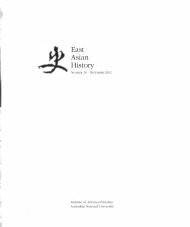Portrait of a Tokugawa Outcaste Community ... - East Asian History
Portrait of a Tokugawa Outcaste Community ... - East Asian History
Portrait of a Tokugawa Outcaste Community ... - East Asian History
Create successful ePaper yourself
Turn your PDF publications into a flip-book with our unique Google optimized e-Paper software.
108TIMOTHY D. AMOSConclusionRelations between neighbouring eta and hinin communities changedduring the first half <strong>of</strong> the eighteenth century. What were formerly disputesbetween eta communities over tanning duties in the previous centuryshifted to conflicts concerning policing jurisdiction. Within this process,the position <strong>of</strong> eta and hinin within rural Musashi also became ambiguous.On the one hand, they were visibly able to project their will on numerousmatters related to policing and execution in disputes with local peasantsand authorities. But on the other hand, their authority to discipline andpunish criminals was quite distinct from warrior law enforcement thatretained a function <strong>of</strong> intimidation that was capable <strong>of</strong> deterring illegalactivities. The refusal <strong>of</strong> communities to pay for the eta and hinin guardduties clearly demonstrated the tenuity <strong>of</strong> outcaste claims to this kind <strong>of</strong>punitive power.The discourse <strong>of</strong> the commoner based on a notion <strong>of</strong> normalityalso came to significantly impact social practices in within Lower Wanavillage in the second half <strong>of</strong> the eighteenth century. The head-on collisionbetween Upper and Lower Wana village over the hinin hut in 1768 isperhaps one <strong>of</strong> the first clear evidences <strong>of</strong> a clash between these two communitiesbased on such a discourse. Naturally, the ultimatum presentedby the Upper Wana villagers to their Lower Wana counterparts was notnecessarily the result <strong>of</strong> a firm belief in their "outcaste-ness", but perhapsrather a harsh response to a refusal by Jin'emon to ensure the safety <strong>of</strong>their community through the provision <strong>of</strong> a policing agency. Nevertheless,just as the <strong>Tokugawa</strong> shogunate used the discourse <strong>of</strong> the commoner asa mechanism to facilitate stable rule by a homogenisation <strong>of</strong> the populationinto obedient masses, so too did Upper Wana village. They ignoredestablished differences between eta and hinin within Lower Wana andmerged them together as an object which they then attempted to govern.This ensured their control over them and therefore the possibility <strong>of</strong> communalstability.Timothy D. AmosVisiting FellowDepartment <strong>of</strong> Japanese StudiesThe National University <strong>of</strong> Singaporejpsatd@nus.edu.sgLower Wana village certainly attempted to reject these attempts bythe Upper Wana community to merge them into a manageable "outcaste"body. But at the same time, there appears to have been an acceptance bythis community <strong>of</strong> the logic behind claims that Lower Wana communitywas different. Members <strong>of</strong> the Suzuki household began to articulate thisdistinction in terms <strong>of</strong> a unique local identity from the late eighteenthcentury. The <strong>of</strong>ficial discourse <strong>of</strong> commoner-outcaste continued to bemore pronounced during the early nineteenth century until it appearedas a hegemonic discourse by the 1820s. And it is clear that some etapractices related to hinin governance during this time also containedtraces <strong>of</strong> marginalization influenced by this discourse.EAST ASIAN HISTORY 32/33 (200612007)
















